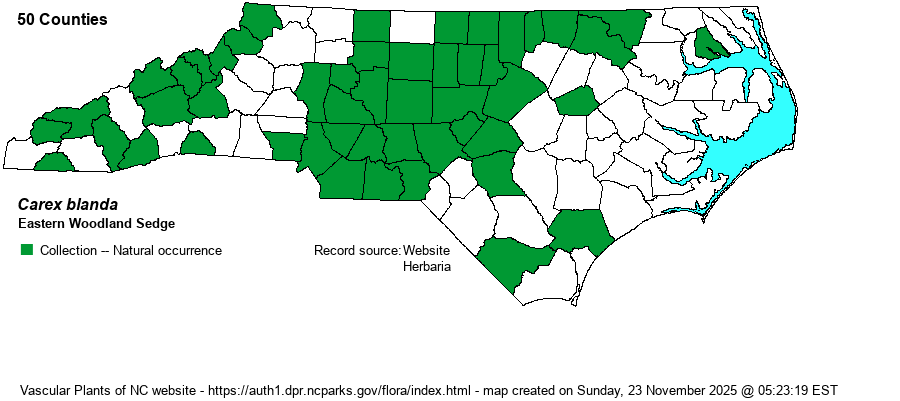| Author | Dewey | |
| Distribution | Mountains and middle and lower Piedmont; rare and scattered in the Coastal Plain, but absent in most areas in that province. The gap in the western Piedmont is hard to explain.
ME and southern Quebec west to ND and south to northwestern FL and NM. | |
| Abundance | Frequent to common in most of the Piedmont and Mountains. Usually found in moderate to large-sized populations. Very rare to rare in the Coastal Plain except in a few areas of brownwater river floodplains. Seemingly rare in the western Piedmont, though no reason for it to be absent. | |
| Habitat | Rich soil of bottomland forests, cove forests, and mesic hardwoods and hardwood-pine forests. |
| Phenology | Flowering and fruiting late April-June. | |
| Identification | The first clue that you may have this sedge is the abruptly bent and short beaks of mature perigynia (don't try to ID it when immature!). The perigynia are crowded and not spaced apart as they are in some other members of the Laxiflorae group. Perigynia are arranged spirally, not distichously as in C. planispicata. The base of the plant is pale brownish, not red-purple as in some other relatives. Perigynia are shorter than those of C. crebriflora, C. styloflexa, and C. chapmanii (2.5-4 mm vs. 3.9-5.5 mm). | |
| Taxonomic Comments | The apparent variability within C. blanda has led some to suggest that there still may be unrecognized taxa within it.
The genus Carex is the largest in North America, and among the largest in the world. In temperate and boreal regions, Carex is often the dominant or co-dominant ground layer in many habitats. Seeds (achenes) are valuable food for birds and small mammals, while foliage is used by birds and mammals to make nests and as food by mammals. Species of Carex often look vastly different from one another -- spikes erect vs. drooping, tiny inflorescence vs. whopping, culms leafy vs. naked, perigynia beaked vs. beakless, stems densely bunched vs. single, etc. The genus has been divided into many sections (or groups), based on shared characters; some taxonomists have suggested that these be different genera, but that proves unworkable (so far). All Carex share the feature of a perigynium (an outer covering) which completely surrounds the achene (seed). This covering may fit tightly or loosely (like a small bladder), depending on which group or species. Details of perigynia shape, ornamentation, presence and size of beak, number of striations (or veins) are all important ID features. In recent years Rob Naczi and colleagues have stressed the importance of arrangement of perigynia -- whether spiral (3+ ranks) or distichous (2-ranked) -- and have named a number of new species as well as split off some older synonyms. Therefore, RAB's (1968) key, excellent for its time, can only be used in a general way today. Members of some sections of Carex are difficult to key out (notably Ovales, Laxiflorae, Griseae); this is in part due to variation among individuals of a species, or failings of the key. FNA has drawings of most species and some species may be found in two or more places within a key, to acount for variability. New species to NC, and new to science(!), continue to be found in NC. | |
| Other Common Name(s) | Common Woodland Sedge, Eastern Wood Sedge | |
| State Rank | S4 [S5] | |
| Global Rank | G5? | |
| State Status | | |
| US Status | | |
| USACE-agcp | FAC link |
| USACE-emp | FAC link |

